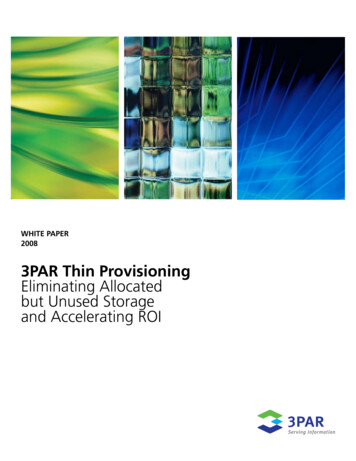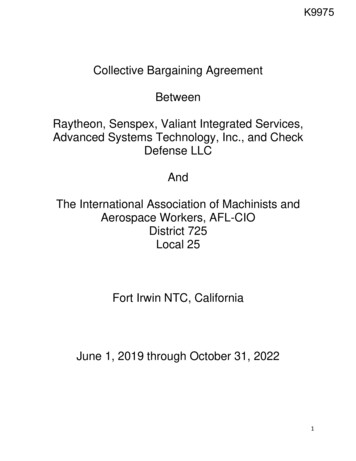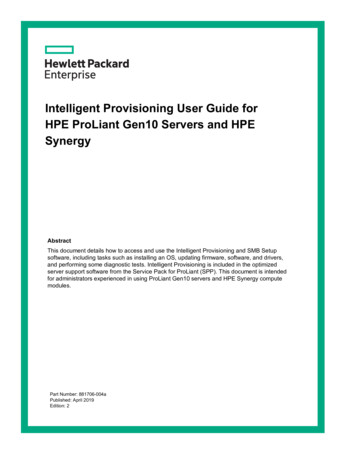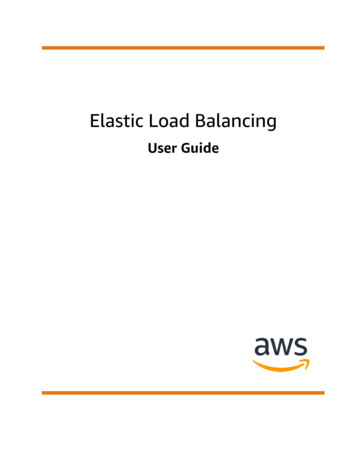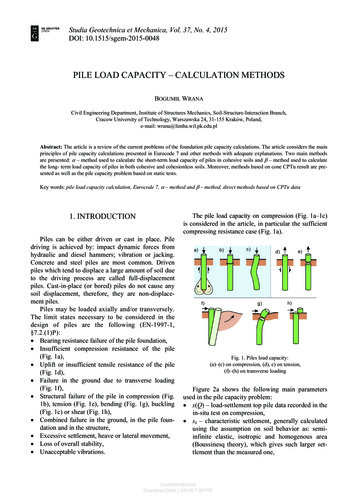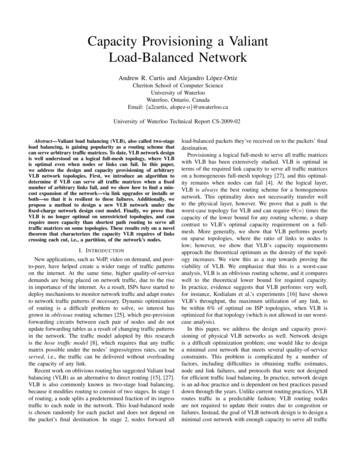
Transcription
Capacity Provisioning a ValiantLoad-Balanced NetworkAndrew R. Curtis and Alejandro López-OrtizCheriton School of Computer ScienceUniversity of WaterlooWaterloo, Ontario, CanadaEmail: {a2curtis, alopez-o}@uwaterloo.caUniversity of Waterloo Technical Report CS-2009-02Abstract—Valiant load balancing (VLB), also called two-stageload balancing, is gaining popularity as a routing scheme thatcan serve arbitrary traffic matrices. To date, VLB network designis well understood on a logical full-mesh topology, where VLBis optimal even when nodes or links can fail. In this paper,we address the design and capacity provisioning of arbitraryVLB network topologies. First, we introduce an algorithm todetermine if VLB can serve all traffic matrices when a fixednumber of arbitrary links fail, and we show how to find a mincost expansion of the network—via link upgrades or installs orboth—so that it is resilient to these failures. Additionally, wepropose a method to design a new VLB network under thefixed-charge network design cost model. Finally, we prove thatVLB is no longer optimal on unrestricted topologies, and canrequire more capacity than shortest path routing to serve alltraffic matrices on some topologies. These results rely on a noveltheorem that characterizes the capacity VLB requires of linkscrossing each cut, i.e., a partition, of the network’s nodes.I. I NTRODUCTIONNew applications, such as VoIP, video on demand, and peerto-peer, have helped create a wider range of traffic patternson the internet. At the same time, higher quality-of-servicedemands are being placed on network traffic, due to the risein importance of the internet. As a result, ISPs have started todeploy mechanisms to monitor network traffic and adapt routesto network traffic patterns if necessary. Dynamic optimizationof routing is a difficult problem to solve, so interest hasgrown in oblivious routing schemes [25], which pre-provisionforwarding circuits between each pair of nodes and do notupdate forwarding tables as a result of changing traffic patternsin the network. The traffic model adopted by this researchis the hose traffic model [8], which requires that any trafficmatrix possible under the nodes’ ingress/egress rates, can beserved, i.e., the traffic can be delivered without overloadingthe capacity of any link.Recent work on oblivious routing has suggested Valiant loadbalancing (VLB) as an alternative to direct routing [15], [27].VLB is also commonly known as two-stage load balancing,because it modifies routing to consist of two stages. In stage 1of routing, a node splits a predetermined fraction of its ingresstraffic to each node in the network. This load-balanced nodeis chosen randomly for each packet and does not depend onthe packet’s final destination. In stage 2, nodes forward allload-balanced packets they’ve received on to the packets’ finaldestination.Provisioning a logical full-mesh to serve all traffic matriceswith VLB has been extensively studied. VLB is optimal interms of the required link capacity to serve all traffic matriceson a homogeneous full-mesh topology [27], and this optimality remains when nodes can fail [4]. At the logical layer,VLB is always the best routing scheme for a homogeneousnetwork. This optimality does not necessarily transfer wellto the physical layer, however. We prove that a path is theworst-case topology for VLB and can require Θ(n) times thecapacity of the lower bound for any routing scheme, a sharpcontrast to VLB’s optimal capacity requirement on a fullmesh. More generally, we show that VLB performs poorlyon sparse topologies, where the ratio of links to nodes islow; however, we show that VLB’s capacity requirementsapproach the theoretical optimum as the density of the topology increases. We view this as a step towards proving theviability of VLB. We emphasize that this is a worst-caseanalysis, VLB is an oblivious routing scheme, and it compareswell to the theoretical lower bound for required capacity.In practice, evidence suggests that VLB performs very well,for instance, Kodialam et al.’s experiments [16] have shownVLB’s throughput, the maximum utilization of any link, tobe within 6% of optimal on ISP topologies, when VLB isoptimized for that topology (which is not allowed in our worstcase analysis).In this paper, we address the design and capacity provisioning of physical VLB networks as well. Network designis a difficult optimization problem; one would like to designa minimal cost network that meets several quality-of-serviceconstraints. This problem is complicated by a number offactors, including difficulties in obtaining traffic estimates,node and link failures, and protocols that were not designedfor efficient traffic load balancing. In practice, network designis an ad-hoc practice and is dependent on best practices passeddown through the years. Unlike current routing practices, VLBroutes traffic in a predictable fashion; VLB routing nodesare not required to update their routes due to congestion orfailures. Instead, the goal of VLB network design is to design aminimal cost network with enough capacity to serve all traffic
2matrices even under failures.We show how to design an optimal VLB network under thefixed-charge cost model, which allows the network operatorto estimate the expense of installing a link between eachpair of nodes. We give an integer program (IP) that designsa minimum-cost VLB network under the fixed-charge costmodel. We show that this IP formulation can also be used tofind a min-cost upgrade—via link upgrades and/or installs—toan existing network that does not have enough link capacityto serve all traffic matrices with VLB.The results we have described thus far rely on a theoremwe give in Section III that characterizes the capacity of linkscrossing each cut, a partition of the network’s nodes, in orderto serve all traffic matrices with VLB. This theorem is thetheoretical power behind the other results presented here.II. P ROBLEMS , M ODEL , AND OUR A PPROACHPrevious work has left open important questions regardingVLB’s behavior, including the following. Can a network serve all traffic matrices with VLB whenk arbitrary links fail? Previous work has answered thisquestion for the case when no failures occur by findingthe maximum throughput of a network using VLB [16]. Ifthe throughput is at least 1, then VLB can serve all trafficmatrices. We give an algorithm to resolve the questionwhen links can fail in Section III. The power behindthis algorithm is a theorem we give that characterizesthe required capacity of all links crossing each cut of anetworks’s nodes. How much capacity does VLB require on arbitrarytopologies? An implication of a theorem of Babaioffand Chuang is that a homogeneous full-mesh is the onlytopology on which VLB is the optimal routing schemewhen VLB load balances traffic evenly to all nodes instage 1 [4]. Our work sets to determine what’s the worstcase capacity requirements of VLB and what topologiesVLB performs poorly on. We show that the topologywhich elicits worst-case VLB behavior is a path on nnodes. We show that as links are added to a VLB network,its worst-case required capacity decreases linearly withthe number of additional links. These results are given inSection IV. How to design a VLB network at the physical layer?As mentioned, previous VLB network design work onlyapplies to the logical layer, e.g., [4], [27]–[29], andthere is no clear method to translate these results to thedesign of arbitrary topologies. We propose an approachto physical layer VLB network design in Section V.Before giving the details of our results, we present the modelsand notation used throughout the remainder of this paper.A. Traffic modelWe assume that the amount of traffic entering and exitingthe network from each node is fixed and that the two valuesare equal. We say that the amount of ingress/egress traffic atnode i is the rate of i and we denote this value by ri . Weassume that the rate of a node is bounded by the sum of theingress/egress links to that node; this is known as the hosemodel [8], which was originally used to specify the bandwidthrequirements of a Virtual Private Network (VPN).We wish to consider traffic matrices that respect the ratesof each node, i.e., no node initiates or receives more than ritraffic. A traffic matrix is an n n matrix where the i, j entryindicates the amount of traffic node i is currently sending nodej. For a traffic matrix D, we requireXXDij ri andDji ri i Vj V,j6 ij V,j6 iwhere D is a traffic matrix of a network G (V, E) withnode rates r1 , . . . , rn . As observed in [15], it is enough toconsider only the traffic matrices whereP each node sends andreceivesatitsmaximumrate,i.e.,j V,j6 i Dij ri andPj V,j6 i Dji ri , and we say that such a traffic matrix is avalid traffic matrix (VTM). We are interested in being able toserve any VTM, so we do not require that the traffic matrixof a network is static, only that it always remains valid.B. Modeling VLB at the physical layerValiant load balancing (VLB) is also known as two-stagerouting, because packet routing is done in two stages. Stage 1is a load balancing step which sends packets to an intermediatenodes, and stage 2 forwards packets to their final destination.In detail, the two stages behave as follows. Stage 1 Each node forwards a predetermined fractionof its ingress traffic to each node in the network; thisforwarding is done without regard for each packet’s finaldestination. The fraction of each node’s traffic node jreceives during stage 1 is specified by αj . Stage 2 Packets received during stage 1 are forwardedon to their final destination.We call α1 , . . . , αn thePload balancing parameters of thennetwork, and we require i 1 αi 1. We also consider aVLB variant where we require α1 · · · αn , which wecall strict Valiant load balancing (SVLB). In practice it onlymakes sense to use SVLB on a homogeneous network witha full-mesh topology; however, we use it here for theoreticalanalysis.We assume that if node i is sending traffic to node j at rateDij , where Dij is i, j entry in the current traffic matrix D,then node x receives exactly αx Dij /n packets destined for jduring stage 1 of routing. In practice, it’s unlikely that trafficfor each destination would be load-balanced exactly evenly asin this assumption; however, if each packet is sent to a randomnode during stage 1 according to the distribution α1 , . . . , αn ,then our results hold inPexpectation. Since we are dealing withtraffic matrices where j V Dij ri , node j receives exactlyαj ri traffic from i during stage 1 and αi rj traffic from i duringstage 2, so we have that i is sending a total of αj ri αi rjtraffic to j.The logical layer view of VLB is a full-mesh and eachpacket is forwarded along two-hop paths. First to an intermediate node, and then on to its final destination. However,
3at the physical layer, this two-hop logical path may be muchlonger, so we must specify the paths that packets follow whensent from i to j. At the logical layer, specifying the loadbalancing parameters is enough to specify a solution to theVLB routing problem since all nodes are connected by alogical link; however, since we work with arbitrary topologies,we must specify the path Pij packets sent from i to j follow.In multi-path VLB, a node i can forward to j along multiplepaths, which we define in terms of a flow. For a pair of nodess, t, an s-t flow with rate f assignsP a value f (P ) to eachpath from s to t in G such that P f (P ) f . We denotethe amount of traffic flow f places on a link e by f (e).The following are the VLB routing variants we consider. A solution to the single-path VLB routing problem consists of the set of traffic split ratios α1 , . . . , αn togetherwith a path Pij for all i, j V that indicates the pathtraffic forwarded from i to j follows. In the multi-path VLB routing problem, a solution consistsof a set of traffic split ratios α1 , . . . , αn along with a flowfij for each pair i, j V such that fij αj ri αi rj ,where ri is the rate of node i; the set of all flows isdenoted by P {fij : i, j V }.We say that a solution to either VLB routing problem is afeasible solution if no link carries more traffic than its capacity.C. Definitions and NotationLet G (V, E) be a network with node set V and linksE. We denote a link by e or by specifying its endpoints, soa link from i to j is denoted (i, j). We assume that links arebidirected, i.e., whenever (i, j) E we also have (j, i) E.We use n to denote the number of nodes in a network, i.e.,let n V , and m E denotes the number of links ina network. The nodes connected to i by a link are called i’sneighbors. We assume that all links in E have a capacity,which indicates the maximum number of bits they can carryat once. We denote the capacity of an link e by c(e). Wesay that the utilization of a link is the amount of traffic it iscarrying divided by its capacity. When studying link failures inthis paper, we assume that no failure disconnects the network,that is, we assume there is always at least 1 path between allnode pairs.III. D OES A N ETWORK H AVE E NOUGH C APACITY ?In this section, we give a combinatorial algorithm to find afeasible solution to the multi-path VLB routing problem. Ouralgorithm relies on a characterization of the capacity linkscrossing each of a network’s cuts require, which we describein Section III-A. This theorem is easily used to determine ifa feasible multi-path VLB routing solution exists when upto k arbitrary links fail, which we describe in Section III-B.Before presenting either of these results, however, we describethe VLB routing problem as a multicommodity flow problem,which we use throughout the rest of this paper.As mentioned, the case when no failures occur has beensolved by Kodialam et al. They have described a linearprogram (LP) which finds the maximum throughput multipath VLB can obtain on a given network [16]. By findingthe max throughput, they also determine if a feasible solutionto the multi-path VLB routing problem exists, since anyfeasible solution must have a throughput that is at least 1.The single-path VLB routing problem is NP-hard; however,Kodialam et al. gave a fully polynomial-time approximationalgorithm for the problem in [13], so it is possible to find anapproximate single-path VLB routing that is arbitrarily closeto the optimal single-path VLB routing in polynomial-time.VLB as a multicommodity flow The VLB routing problemcan be described as a multicommodity flow, which generalizesthe well-known maximum flow problem to have multiplesource and destination pairs. A commodity is an s-t flowwhere node s sends traffic to node t at a specified rate r,and is denoted by (s, t, r). The multicommodity flow problemtakes as input a set of commodities W {(si , ti , ri )}, anda solution to the multicommodity flow problem is a set offlows P {fsi ti : (si , ti , ri ) W and fsi ,ti ri }; finally,a solution to multicommodity flow problemP W on networkG (V, E) is feasible if for all e E, k W fk (e) c(e),where fk (e) is the amount of traffic sent on e by commodityk.Viewed as a multicommodityflow problem, the VLB rout ing problem is a set of 2 n2 n(n 1) commodities, specifiedas follows.WVLB {((s, i), αi rs )} s, i VStage 1 {((i, t), αi rt )} i, t VStage 2Since we have captured all flows between nodes, it’s clearthat the VLB routing problem with load balancing parametersα1 , . . . , αn admits a solution if and only if the multicommodity flow WVLB has a feasible solution.Thus far, we have not precisely described the commoditiesin WVLB since we have not specified values for α1 , . . . , αn .There are many ways could find values for these load balancing parameters, for instance, values for each αi that maximizesthe network’s throughput, the maximum utilization of a linkin the network, can be found in polynomial-time using an LP[16]. With values for α1 , . . . , αn found by this LP, G can serveall VTMs with VLB if and only if the multicommodity flowWVLB has a solution.A. Characterizing the cuts of a VLB networkFinding a solution to the multicommodity flow problemWVLB ensures that a network can use VLB to serve all VTMs;however, we do not gain any insight into the structure ofnetworks with a feasible solution to WVLB exists. We nowgive a combinatorial algorithm to find a solution to the multipath VLB routing problem. It is based on a theorem we willgive next that describes the necessary and sufficient capacitythat each cut of a network must have in order to serve allVTMs with VLB.The theorem is stated in terms of cuts. A cut is a partitionof V into two disjoint sets, S and V S, such that all pairs
4of nodes i, j S have a path between them that contains onlynodes in S. We denote a cut by (S, V S). We say that anlink (i, j) with i S and j V S crosses the cut, and wedenote the set of all links crossing the cut (S, V S) by δ(S).The capacity of a cut (S, V S) is the sum of capacities oflink in δ(S),and we denote the capacity of (S, V S) byPc(S) e δ(S) c(e).For convenience,we denote the rate of a set of nodes S VPas RS i S ri . Similarly,we denote the sum of αi ’s in aPset of nodes as AS i S αi .The following theorem gives a necessary and sufficientcondition for routing all VTMs regardless of the network’stopology.Theorem 1 (Necessary and sufficient capacity of a cut). Aheterogeneous network G with node rates r1 , . . . , rn and loadbalancing parameters α1 , . . . , αn can serve all valid trafficmatrices using multi-path VLB routing if and only if, for allcuts (S, V S) of G,c(S) AV S RS AS RV S g(S)Pwhere PRS i S ri is the sum of node rates in S V andAS i S αi .Proof: Necessity is not difficult to show by way ofcontradiction. We omit the details here; see, e.g., [19] for aproof that necessity holds in any multicommodity flow.Assume that all cuts (S, V S) of G have capacity at leastg(S). To see that G can serve all VTMs, we will show thatthere exists a feasible solution to the multicommodity flowproblem WVLB . We need to specify the rate of a commodity,so let r(k) r for a commodity k (s, t, r). And we denotethe set of i’s incoming links by N (i) and i outgoing linksby N (i).A directed graph is called capacity balanced if, for alli V , N (i) demand(i) N (i) supply(i), wheredemand(i) is the sum of commodity rates with i as the targetand supply(i) is the sum of commodity rates where i is thesource. Nagamochi and Ibaraki [20], [21] have shown that afeasible solution to a multicommodity flow problem W existson a capacityP balanced network if, for all its cuts (S, V S),c(S) k WS r(k), where WS {(s, t, r) W : s S and t V PS}.We assume k WS r(k) AV S RS AS RV S for themulticommodity flow WVLB , since necessity holds, so if G isa capacity balanced network, then a feasible solution to WVLBexists. Consider an arbitrary i V . we have N (i) N (i)by definition, since G is Pbidirectional. In a VTM D, we havePD randij V,j6 i ijj V,j6 i Dji ri , so supply(i) demand(i). Therefore, G is a capacity balanced network, andso a feasible solution to WVLB exists.In the proof of Theorem 1, we show that the demandsWVLB are capacity balanced, so a combinatorial polynomialtime algorithm exists for the multi-path VLB routing problem[20]. However, this algorithm does not find optimal valuesfor α1 , . . . , αn , so this algorithm is still dependent on theLP of [16] to find optimal settings for these load balancingparameters. We note that if one solves the LP of [16], it returnsa solution to the multi-path VLB routing problem, so solvingthe VLB routing problem with this combinatorial algorithm isredundant.The statement of Theorem 1 gives an easy algorithm todetermine if a feasible solution to WVLB exists on a networkG; however, the runtime of this algorithm is exponential. Wepresent it here to show the usefulness of Theorem 1 andbecause we will modify it to account for link failures shortly.The algorithm follows.1) Find values for α1 , . . . , αn using the linear program tomaximize throughput described in [16].2) Enumerate all cuts of G. Let the set of all cuts be C.3) For each cut (S, V S) C, if c(S) g(S) then Gcannot serve all VTMs.Unlike the LP described earlier for determining if a networkcan serve all VTMs with VLB, the runtime of this algorithm isexponential in n, as a network may have exponentially manycuts. Many algorithms exist to enumerate all cuts [1], [11],[23] and they are able to find all cuts in time proportional tothe number of cuts in the graph; however, this number maybe exponential in n.B. Serving all valid traffic matrices with link failuresWe now show how Theorem 1 can be used to determine ifa network can withstand link failures. We say that a networkis k link resilient if it can serve all VTMs after k arbitrarylinks are removed.We show that a slight modification of our combinatorialalgorithm to check if a network can use VLB to serve allVTMs can also be used to check if a network is k link resilient.The observation behind the algorithm is that Theorem 1 holdsregardless of the number of links crossing a cut, so it gives anecessary and sufficient condition for a network to serve allVTMs under link failures: if a set of links fail, the capacity ofall cuts (S, V S) of the network must remain at least g(S).Therefore, the following algorithm can be used to determinewhether or not a network is k link resilient. As before, thealgorithm’s input is a network G (V, E) with link capacities,rates r1 , . . . , rn for each node, and load balancing parametersα1 , . . . , αn .1) For all cuts (S, V S) of G, let e1 , . . . , e δ(S) be thelinks in δ(S) ordered such that e1 · · · e δ(S) .Pk2) If c(S) i 1 c(ei ) g(S), then G cannot serve allVTMs under k link failures.The worst-case runtime of this algorithm is again exponentialsince a network can have exponentially many cuts. Even so, itis practical to compute it for small networks. We enumeratedthe cuts of networks with size n 20 in a less than a minutewith a naive Python script; more sophisticated techniques existfor larger networks [1], [11], [23].A weakness with this algorithm as specified above is thatwe do not update the load balancing parameters after linksfail; changing these parameters may modify routes enoughthat the network could serve all VTMs after the link failures.
5This can be resolved, at additional computational expense, bymodifying step 2 above so that after removing the k highestcapacity links, e1 , . . . , ek , from a cut, the load balancingparameters α1 , . . . , αn are updated using the LP of [16].Allowing the load balancing parameters to be updated aftera failures raises questions about how to update the loadbalancing parameters online. In one approach, taken by [14],[17], a solution to the VLB routing problem is precomputedfor a set of node or link failure scenarios. Then, in the eventof a failure, nodes switch to these precomputed routes andsettings for α1 , . . . , αn .IV. W ORST-C ASE C APACITY R EQUIREMENTS OF VLBIn this section, we study the necessary and sufficient capacity VLB needs to serve all VTMs on a topology G; wedenote this capacity requirement by LSVLB (G). We begin byproving that VLB requires the most capacity when G is a pathin Section IV-A. We next give an example of how LSVLB (G)decreases linearly as additional links are added to G in SectionIV-B. Finally, we conclude this section with a brief comparisonof SVLB and shortest path (SP) routing in Section IV-C.For our analysis, we consider only homogeneous networks,where each node has rate r. We primarily analyze strict Valiantload balancing (SVLB), where α1 · · · αn , no matterthe topology since it is easier to analyze than VLB. Similarlyto the definition of LSVLB (G), given a network G using SProuting to serve all VTMs, we denote the minimum necessaryand sufficient sum of its link capacities by LSP (G).A. Worst-case topology for SVLB is a pathWe seek to find the topology which requires the mostcapacity to serve all VTMs with SVLB. We begin by showingthat adding additional links to a network using VLB does notever increase the network’s necessary capacity.Lemma 2. Let G (V, E) be a network that can serve allvalid traffic matrices using single- or multi-path VLB and letG0 (V, E F ) be a network that is obtained by adding aset of links F to G. Then LVLB (G0 ) LVLB (G).Proof: We can set c(e) 0 for all e F and G0 can serveall VTMs using the links in E with their original capacitiessince G can serve all VTMs.This lemma implies that the worst-case topology for VLB,and consequently SVLB, must be a tree, a topology withexactly one path between each pair of nodes. This resultcontrasts a recent advance on direct routing, which shows thata tree is the optimal topology for single-path direct routing[10]. We will give an example of how adding additional linksto a network can decrease its necessary capacity momentarily(Section IV-B); first, we show that a path is the worst-casetopology for SVLB.A path is a tree, denoted by Pn (V, E) where V {0, 1, . . . , n 1} and each node i is neighbors with i 1 andi 1, except for when i 0, n 1, then i has one neighbor, 1and n 1 respectively. The following shows that a path is theworst-case topology in terms of necessary total link capacitywhen using SVLB.Theorem 3. For any homogeneous network G, LSVLB (G) ismaximized when G is a path.Proof: We present a sketch for space reasons. By Lemma2, we only have to show that LSVLB (G) is maximized when Gis a tree. Suppose that the claim holds for trees with up to n 1nodes; let Gn 1 (Vn 1 , En 1 ) be a path on n 1 nodes,and let n 3. Consider adding a node x to Gn 1 such thatthe resulting graph Gn (Vn 1 {x}, En 1 {(x, j), (j, x)})is not a path, that is, j 6 1, n 1. Using Theorem 1, we havethatn 1 4r Xi(n i) j(n j) (n 1)LSVLB (Gn ) n i 1To compare this to the necessary capacity of a path, let Pnbe a path on n nodes. We have thatn 12r Xi(n i)LSVLB (Pn ) 2n i 1(1)This gives 4r j(n j) (n 1)nSince 1 j (n 1) and n 4, we have j(n j) (n 1),giving LSVLB (Gn ) LSVLB (Pn ) as desired.LSVLB (Gn ) LSVLB (Pn ) We can now compute the worst-case capacity for SVLBusing Eqn. 1.LSVLB (Pn ) 2n 1Xi 12r2(n2 1)ri(n i) n32We now have that 2(n 1)r/3 is an upper bound on thecapacity required to serve all VTMs with SVLB; previouswork [27] has shown that 2r(n 1) is a lower bound onthe amount of capacity required by SVLB on a homogeneousfull-mesh. We will discuss how these bounds compare with SPand optimal routing in Section IV-C. First, we give an exampleof how increasing the number of links in an SVLB networklowers its capacity requirements.B. How LSVLB (G) is affected by additional linksLemma 2 implies that adding links to a network reduces thecapacity required by for the network to serve all VTMs withVLB, but it does not specify how much LSVLB (G) decreases(if any) when a new link is added to G. To get an idea for howadditional links affect the necessary and sufficient capacity ofan SVLB network, we’ll show how LSVLB (G) changes as weadd additional links to a cycle. Let Cn denote a network thatis a cycle, i.e., if V {0, . . . , n 1}, then each node i hastwo neighbors i 1 mod n and i 1 mod n.Because of a cycle’s structure, it’s easy to computeLSVLB (Cn ). For each link, we need to find the cut it crossesthat maximizes 2r/n · S · V S . Since (S, V S) must
6SP on fullmeshRequired capacity (in units of r)60005500In the table, we give the best- and worst-case values forLSVLB (G) and LSP (G) on any topology G. For each routingscheme considered, we list the topology that brings about thebest- or worst-case behavior.SVLBWC50004500SVLB Cn,140003500Cn,3300025002000V. VLB N ETWORK D ESIGNCn,615001000500n Lower bound102030405060708090100110120130140150Fig. 1. Comparison of LSP (G) and LSVLB (G) for various topologies. Fromtop to bottom, the curves represent the capacity requirements of SP routingon a full-mesh topology, SVLB on a path (the worst-case behavior of SVLB),SVLB on Cn,1 , SVLB on Cn,3 , SVLB on Cn,6 , and the lower bound forany routing scheme.partition V , we have c(S) 2r/n · bn/2c · dn/2e. Forsimplicity of presentation, we assume that n is even. In aneven cycle, each link crosses a cut (S, V S) where S n/2and V S n/2. Here, we have δ(S) 2, and theoptimal routing strategy is to place 1/2 of the flow from Sto V S on each link in δ(S). Then, Theorem 1 impliesc(e) 1/2 · 2r/n · n/2 · n/2 rn/4 for all e E. Therefore,we havern2LSVLB (Cn ) 2when n is even since there are 2n links in Cn .We’d like to be able to add more links around this cycle,so we define Cn,l be a network where V {0, . . . , n 1}and node i has neighbors {j k mod n : k {1, . . . l}} andl n/2, so therefore Cn,1 has 2n links, Cn,2 has 4n links,Cn,3 has 6n links, and so forth. We omit the details here, butwe can compute the required capacity for Cn,l , determiningthatn2 rLSV LB (Cn,l ) k 1when n is even and k n/2.In Figure 1, we show the required capacity to route all trafficmatrices with SVLB on Cn,1 , Cn,3 , and Cn,6 . As can be seenin the figure, SVLB behaves very well while n is small onCn,3 , and Cn,6 . As n increases, however, Cn,3 , and Cn,6 pullaway from the lower bound as their growth rate is Θ(n2 )r.The required capacity to serve all VTMs with multi-path SProuting is also shown in the figure. As shown, LSP (G) whenG is a full-mesh requires more capacity than the worst-caseLSVLB (G) for any topology.C. Comparison of SVLB, SP, and optimal routingFinally, the following table summarizes our findings aboutthe capacity requirements of SVLB and SP routing.Routing schemeSVLBWorst-case2(n2 1)r/3Best-case2r(n 1) [27]topologypathfull-meshShortest path rn(n 1)2r(n 1)topologyfull-meshstarIn this section we show
be within 6% of optimal on ISP topologies, when VLB is optimized for that topology (which is not allowed in our worst-case analysis). In this paper, we address the design and capacity provi-sioning of physical VLB networks as well. Network design is a difficult optimization problem; one would like to design
